Maintenance & FAQs
Troubleshooting Guide & Glossary
Outlined in this guide are many of the reasons filter elements “fail” and are replaced or returned for warranty. Typically the damage to the element is the result of misuse, abuse or neglect. With this troubleshooting guide and the accompanying cleaning instructions, we hope to prevent these problems from occurring. We feel that this goal can best be accomplished by assisting you in your effort to educate users in the proper care and handling of filter elements.
New Cartridges
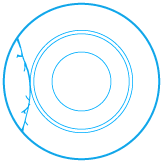
CRACKED END CAP
A crack arching across the outside diameter or one radiating from the core to the outer edge of the end cap is typically the result of mishandling during warehousing or in transit. Cartridge end caps are made of plastic and can break if dropped or otherwise mishandled.
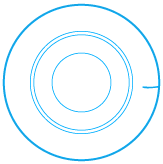
CRACKED END CAP
A small crack extending in from the outer edge of the end cap may be the result of an abnormality during the curing of the end cap material. This crack develops after the element has been removed from the mold and packaged for shipment. It will be noticed when the cartridge is removed from the box.
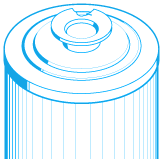
BROKEN HANDLE
The handles on some cartridges are made of plastic and will break if dropped or otherwise mishandled.
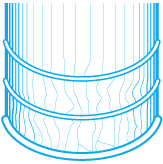
CRUSHED PLEATS
The pleats of a new cartridge will crush if the element is not properly warehoused. Cartridge pleats will crumple under the weight of heavy objects stored on top of them. Unless the damage to the pleats is excessive, the performance of the element will not be hindered.
Used Cartridges
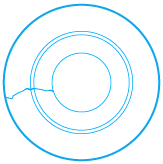
CRACKED END CAP
Plugged or restricted filter media is the most common cause of cracked end caps on used cartridges. Operation of the pumping system when the media is clogged and water flow restricted creates a high differential pressure. This causes the end cap to bend and, ultimately, crack. Frequent and proper cleaning of the cartridge will prevent the end caps from cracking during use.
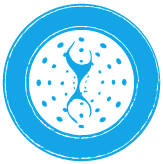
COLLAPSED CORE
When cartridges are not periodically and properly cleaned, accumulated dirt and debris will clog the filter media. Continued operation of the pumping system will create excessive pressure which can collapse the core in the center of the element.
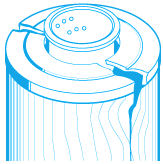
PLUMBED BACKWARD
When a cartridge is used in a canister through which the water flow is reversed, or “plumbed backward,” debris will collect between the filter media and the center core of the element. Accumulated debris plugs up, or “blinds off,” the media such that the water will not flow properly and pressure will build up inside the filter cartridge. Eventually, the pressure increases to the extent that the end cap(s) crack to release the pressure.
Unless the water flow is corrected, this failure will continue. Your customer should be notified immediately so that corrective action can be taken before another element is installed.
KEY INDICATORS THAT A CARTRIDGE IS BEING USED IN A PLUMBED BACKWARD SYSTEM:
- Crack on the end cap follows the circumference of the center core and extends outward at each end of the arc (see illustration).
- Pleats are ballooned outward (potentially causing the bands to break), with folds that are “puffy,” not sharp.
- Debris is accumulated on the inside surface of the pleat pack (the area between the media and the core).
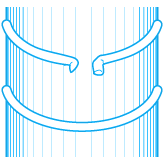
BROKEN BAND
The bands on an element were designed to space the pleats. The element will function properly even if all the bands were broken or missing. A cartridge need not be replaced because of missing or broken bands.
EFFECTS OF IMPROPER OR INFREQUENT CLEANING
Elements which are improperly and infrequently cleaned become caked with excessive dirt and debris. This cake restricts water from flowing through the filter media. Cracked end caps, collapsed cores and bypassing are all primarily caused by the user’s failure to clean the element. It is imperative that the element be cleaned on a regular basis.
Glossary of Filtration Terms
Backwash
The process of cleaning the filter medium or septum by reversing the flow of water through the filter.
Basecoat
A layer of filter aid between the precoat and septum.
Blinding
Filling in and clogging of a filter medium caused by entrapment of particles from a filtered liquid. When the medium becomes “blind,” an increase in differential pressure and reduction in flow results.
Bridging
Debris which arches, or bridges, the individual pleats in the filter cartridge or between two filter elements.
Cartridge Filter
A filter that utilizes a pleated, porous medium as a filtering material.
Clarification
The process by which the filter removes progressively smaller particles on each successive turn over, thus improving efficiency and extending the cycle life. Cartridge filters use the clarification process.
Clarifier (also called coagulant or flocculent)
A chemical that coagulates and neutralizes suspended particles in water. There are two types of clarifiers: inorganic salts of aluminum or iron and water-soluble organic polyelectrolyte polymers.
Coagulation
The process by which very small, finely divided solid particles — often colloidal in nature — are agglomerated into larger particles.
Compressibility
Degree of physical change in a filter cake when it is subject to pressure, resulting in increased differential pressure and reduced flow.
D.E.
Abbreviation for diatomaceous earth. Fossil-like skeletons of microscopic water plants called diatoms.
Denier
The relationship between cross sectional area and weight. Denier is numerically equal to the weight in grams of 9000 meters of individual fiber (i.e. 1 gram equals 1 denier). Most filtration grade Reemay use 4 denier fibers. These fibers are approximately 28 microns in diameter.
Differential Pressure
(1) The difference in pressure between two given points. (2) The combined pressure caused by the debris, filter cake, precoat and septum, expressed as (“delta P”). (3) The effluent pressure minus the influent pressure.
Effluent
Fluid which has passed through a filter. Also called the filtrate.
Enzymes
An organic protein, also known as amino acids. Enzymes are non-toxic and biodegradable. Although they are not an oxidizer or clarifier, enzymes significantly reduce cartridge maintenance by breaking down oils into carbon dioxide and water.
Feed
The mixture of particles and fluid that is introduced into the filter. Terms used synonymously include “influent” and “incoming slurry.”
Filter
Verb: To pass fluid containing suspended particles through a filter medium whereby the particles are separated from the fluid. Noun: A “device” for carrying out the filtration process, consisting of the filter medium and suitable hardware for constraining and supporting it in the path of the fluid.
Filter Aid
Any material (usually diatomaceous earth) that enhances the separation of solids from liquids in the filtration process.
Filter Cake
The combined layers of solids, precoat, and debris removed in the filtration process and accumulated on the surface of the filter medium.
Filter Cycle
The operating time between cleaning or backwash cycles.
Filter Medium
The permeable material such as diatomaceous earth, sand, or polyester nonwoven material used to separate suspended particles from liquid.
Filtrate
Fluid that has passed through a filter. Also called the effluent.
Filtration
The process by which particles are separated from a liquid by passing through a permeable material.
Filtration Rate
Flow in gallons per minute (GPM) through one square foot of filter medium. For residential pools, the filtration rate should be 2 GPM per square foot of D.E. filter surface area and 1 GPM per square foot of cartridge filter surface area. For most commercial pools, the filtration rate should be 1 GPM per square foot of D.E. filter surface area and .375 GPM per square foot of cartridge filter surface area.
Flocculation
The process by which small dispersed particles combine together to form larger size particles which can be removed by the filter. The result of adding an electrolyte to the water.
Hydrophilic
Water accepting. The ability to absorb water.
Hydrophobic
Water rejecting. Lacking affinity for or ability to absorb water.
Influent
Dirty or unfiltered water introduced to the filter. Also referred to as “feed” or “incoming slurry.”
OEM
Original Equipment Manufacturer or brand name.
Micron Size
Expressed as micrometer (µm), a unit of measurement equal to 1/1,000,000 of a meter (.0000394″). 40 micron is considered the smallest size particle visible to the human eye. A red blood cell is 6-8 micrometers large; one grain of table salt is roughly 100 micrometers in size.
Permeability
Expressed in cubic feet per minute (CFM), the resistance to flow through a media. The lower the perm number, the greater the resistance. The permeability of a filter media is a quality control measure for cartridge and D.E. filter materials.
Polyester
Long chain synthetic polymer composed of at least 85% by weight of ester of dihydric alcohol and terephthalic acid.
Polymer
High molecular weight organic compound whose structure can be represented by repeated small units. Synthetic polymers are formed by condensation polymerization of monomers. If two or more monomers are involved, a copolymer is formed.
Porosity
(1) The degree of open area between the fibers. (2) The void area which exists in the structure.
Precoat
The layer of filter aid (usually D.E.) formed on the media surface by introducing a slurry (generally between .1 and .2 lbs. per square foot of surface area) to the medium at the beginning of the filter cycle.
Reemay
A registered trademark of Reemay, Inc. Originally developed by DuPont, Reemay is made of continuous filament, 100% polyester fibers. The process by which these fibers are drawn, randomly laid and thermally bonded is known as “spunbonding.”
Septum
A permeable material used to support the filter medium or precoat on D.E. filters.
Trilobal
The three sided fiber formed by drawing polyester resin through a die or spinneret. The basic shape of Reemay fibers.
Turbidity
(1) The characteristic or property of a liquid that causes it to absorb or scatter light. (2) A measurement of water cloudiness or haziness caused by micro-organisms, algae, or suspended fine particles.
Frequently Asked Questions
Cartridge Filters
Acid Wash
Acid Washing is perhaps the biggest single factor leading to premature cartridge failure.
For years, service technicians and homeowners have acid washed D.E. grids. However, cartridge elements do not have the protective D.E. powder coating that grids have and can be permanently damaged by the acid. As a rule of thumb, acid wash only when required, if at all, and never without thoroughly cleaning the element with a cartridge degreaser first.
Here is a simple test to determine if acid washing is required.
After thoroughly cleaning the cartridge with a degreasing agent, flush the cartridge with a garden hose to remove all traces of soap, etc. Now apply several drops of acid directly to a small area of the filter media. If bubbling occurs, this indicates a build-up of calcium or minerals, and you should proceed with a mild acid soak (see Unicel Cleaning Instructions for more details). If no bubbling is observed, your cartridge most likely does not require acid washing.
Cleaning a Cartridge Filter
Question: Is there an easy way to know when to clean a cartridge filter?
Yes, Cartridge filters work on the clarification process.
They utilize the debris they collect as an aid to improve filtration. As a result, cleaning too often does not allow the filter to work at optimum filtration efficiency, while not cleaning often enough will shorten the life of a cartridge element.
| So here’s a tip. When you replace the element with a new one, note the start-up pressure on the tank gauge. This reading is the system’s total pressure in “pounds per square inch” or psig (gauge). Mark this point with a drop of fingernail polish or a grease pen. Then add 8 pounds to the reading and place another dot. You now have the normal operating pressure for your cartridge in psid (differential). Allow the filter to operate between these two points and clean whenever the gauge reaches the higher pressure mark. |
Cartridge Cleaning Instructions for Chlorine Users
Question: When should a cartridge element be cleaned?
For swimming pools, clean the cartridge when filter canister pressure reaches 8 PSI above the initial system or new cartridge starting pressure. For spas, establish a routine cartridge cleaning schedule based on the amount of spa usage. If Baquacil® is used as a sanitizer, the filter element must be cleaned with Baqua Clean® before any cartridge cleaner is used (Step4). Please refer to “Cartridge Cleaning Supplement for Baquacil® Users.”
Question: What is the procedure to clean my cartridge?
- Remove the cartridge from the filter housing following the manufacture’s instructions.
- Use a garden hose with a straight flow nozzle to wash down the filter element. Work from the top down, holding the nozzle at a 45 degree angle, and wash all the pleats with emphasis between pleats.
- Rinse until all dirt and debris is gone.
- For all spa cartridges and elements used in swimming pools where perspiration, suntan lotions, and other oils are present, soak the element for at least one hour (over night is more effective) in (1) a commercial filter cleaner; or (2) one cup trisodium phosphate (TSP) to five gallons water; or (3) once cup dishwasher detergent to five gallons of water.
- Rinse the cartridge again to remove oils and cleaning solution.
- If the filter has a coating of algae, calcium carbonate (residue from calcium hypochlorite), iron, or other minerals, soak the cartridge in a solution of one part muriatic acid to twenty parts water until all bubbling stops. WARNING: Failure to remove all oils and cleaning solution before acid soaking will result in a permanent restriction of water flow and cause premature cartridge failure.
- Rinse the cartridge clean an reassemble housing.
WARNING: Wear rubber gloves and safety glasses when using acid and chorine. Do not add water to acid. Do not mix chlorine and acid.
NOTE: Unicel does not recommend the use of diatomaceous earth (DE) with cartridge filter. DE particles will become trapped in the body of the media and shorten cartridge life. If desired, a cellulose fiber (synthetic DE) can be used in moderation.
Cartridge Cleaning Supplement for Biguanide® Users
Question: What should I know about cleaning my cartridge element if I use a biguanide system such as Leisure Time FreeTM or Baquacil®?
Unlike chlorine which oxidizes the bacteria in the water, the active ingredient in biguanide systems, polyhexamethylene biqunaide (PHMB), destroys the bacterial cells. PHMB locates and binds to the bacterial surfaces, and then attacks the outer bacterial wall. Once this wall has been compromised, the inner cell membrane (the cytoplasmic membrane) is destroyed. This destruction allows the cell contents to disperse into their surroundings where they are further broken down into their elemental parts by a non-chlorine oxidizer such as Leisure Time BoostTM or Baqua Shock®.
In addition, Leisure Time BoostTM and Baqua Shock® are mild coagulants which combine bacterial cells and other small particles in the environment into particles large enough to be trapped by the filter. The resulting deposit is a gray sticky film on the media which can only be removed with Leisure Time Filter CleanTM or Baqua Clean®. If trisodium phosphate (TSP) or any TSP type cleaner is used prior to stripping the film, the cleaner and the gray film will combine to form a gum-like substance. Once this occurs, the substance cannot be removed from the media and the filter cartridge must be replaced.
WARNING: Follow all manufacturer’s instructions, warnings and cautions when using Leisure Time FreeTM or Baquacil® products.
Leisure Time® and Leisure Time FreeTM are registered trademarks of Advantis Technologies, Inc.
End Caps
Question: Some cartridge end caps are hard and others are soft. Some cartridges have one hard end cap and one soft end cap. Why is this?
When cartridge manufacturers design a new filter element, several factors must be considered. One of the most critical is end cap hardness.
To determine the exact degree of shore hardness required, we first must look at the element sealing points. Sealing points both position the element and prevent water by-pass.
Historically, single cartridge systems all used cartridges with inside i.d. friction seals with hard end caps. This design provided both strength and pleat support. However, as filters became more sophisticated, so did end cap design.
Sta-Rite’s Posi-Flow element, for example, uses a soft vinyl bottom to both seal the inside and outside edges and lock the cartridge into the filter base, while the top end cap is a hard compound for cartridge strength and integrity. Hayward’s Star Clear filter uses hard end caps for integrity with a soft gasket to allow a knife edge top seal. Both the new American Predator and Jacuzzi CFR designs rely on a soft top and bottom to achieve an o-ring seal. These end cap configurations are excellent designs. Only the compounds change to meet the manufacturers’ specifications.
This is another reason why Unicel builds its replacement cartridges to OEM design specifications, and why Unicel is number one in quality and reliability.
Plumbed Backwards
Question: What does the term “plumbed backwards” mean?
Simply put, waterlines that attach to the “inlet” and “outlet” on the filter canister were reversed during installation. In this case, the water flow through the filter element will be from the “inside-out” rather than the “outside-in” (as the filter was intended). Debris rapidly accumulates on the inside of the pleats, water flow is restricted, and the cartridge begins to expand. Eventually, the cartridge’s end cap will split, releasing the internal pressure. The filter element is now being by-passed in the filtration.
Question: How can you tell if your system is plumbed backwards

Is the nature of the split in the end cap similar to this?
• Peel back the broken top and examine the pleats. Is there dirt accumulation on the inside of the pleat pack?
• Does the support band on the outside of the cartridge, if present, appear stretched and wrinkled?
• Do the outside of the pleats appear rounded and puffy?
| If you are still not sure if your filter is plumbed backwards, shut down the entire system and completely bleed the canister pressure. Remove the cartridge and with the lid off quickly turn the pump on and off. Observe which port is delivering the feed water and assure that it is the “inlet.” (Always consult the manufacturer’s instructions before removing the canister lid or working on any pressurized system.) |
Reemay filter Medium
Question: I saw a filter cartridge with yellowish material at one of the trade shows. What is this media and why are Unicel cartridges white in appearance?
Unicel and virtually every brand name company in the filter business uses a spunbonded, 100% polyester material called Reemay® as their filter medium. Reemay®, which has FDA compliance, is approved for milk filtration and is white to indicate purity. The yellowish material (technically also a spunbonded polyester nonwoven) is less expensive.
Some low-end manufacturers are utilizing this material to reduce costs; however, there is a significant difference in cartridge performance.
Replacing a Cartridge Filter
Question: How can I tell when a cartridge filter element needs to be replaced?
With no moving parts or electrical switches to fail, cartridge elements do not have a defined termination point. Instead the fine interstices of the media matrix gradually plug up over time. In a typical spa, the culprit that plugs the media is perspiration and body oils combined with soaps, chemicals and very fine particulate. In a swimming pool, the loading is primarily debris along with sun tan lotions and organic matter such as algae.
Assuming the filter is properly maintained and correctly sized to the pump, determining when the cartridge is exhausted depends primarily on three factors:
- Shorter cycle time between cleanings
- Low water flow rate and high differential pressure
- Catastrophic failure such as a tear in the media or center core collapse
All three are dependent upon proper pool or spa water chemistry and following a routine maintenance schedule. Homeowners should be reminded that filter elements are plastic and should be handled and maintained accordingly.
| To maximize the life of a cartridge I suggest: • Clean the elements per cleaning instructions. • Never use a stiff brush to scrub the media. • Maintain pool or spa water chemistry in proper balance. • Do not allow the differential pressure to go over 8 psi between cleanings. • Alternate two sets of cartridges when cleaning. |
Residential Flow Rate
Question: What is the “residential” flow rate for swimming pool cartridge filters and how does it differ from sand or DE filtration?
Filter manufacturers size all three systems in accordance with the National Sanitation Foundation (NSF) Standard 50 “Circulation System Components for Swimming Pools.” Those ratings are as follows:
1. High-rate Sand:
Max flow rate 25GPM per square foot of surface area, normally sized between 15 and 20 GPM per sq. ft. A minimum flow rate of 11 GPM per sq. ft. is required to utilize the torturous path filtration of depth type filter media. Flow rates over 25 GPM can lead to channeling.
2. Diatomaceus Earth (DE):
Max flow rate 2.5 GPM per square foot of surface area, normally sized at 2 GPM per sq. ft. Proper flow rate and pressure are essential to assure uniform cake formation on the support grids.
3. Cartridge:
Max flow rate 1 GPM per square foot of area, can be sized between 0.25 GPM and 1 GPM per sq. ft.
Question: Why is there such a wide variation in flow for cartridge filters?
Unlike DE or sand filters where the flow rate needs to be specific to optimize the performance of the filter system, cartridge filters can work at any flow rate. In fact, the lower the flow per square foot, the more efficient the system works.
| We suggest that when selling a consumer a replacement cartridge, review your Unicel Replacement Guide to see if an “upgraded surface area” cartridge is available for that system. All upgrades are displayed with the cartridge it is an upgrade for and “upgrade” printed below the part number. For example, on the bottom of page 5 of the Replacement Guide, part C-4637 is identified as an upgrade for part C-4625. C-4637 has 12 more feet of surface area than C-4625 (with all other dimensions the same). |
Sharp Pleat Folds
Question: Sharp pleat folds vs. rounded pleats — is there a difference?
Absolutely! One of the first things a filter expert will look for when examining a pool or spa element is the pleat fold or “knuckle radius” of the pleat. Why is this important? If you look carefully, you will notice that some manufacturers’ pleats are very sharp while others are rounded and even appear puffy. With Reemay or other spunbonded polyester medias it is much easier to make a rounded fold than a sharp pleat. Moreover, a rounded fold can mask the filter manufacturer’s inability to make straight pleats or maintain proper pleat spacing.
At Unicel, we take great care to make our pleat folds sharp. Here’s why:
- Cleanability:
sharp folds increase the spacing between pleats making it easier to flush out loose debris. - Eliminates bridging:
allows particles to get down into the pleat instead of laying across the top of two or more pleats. This assures maximum dirt holding. - Full utilization of the pleat surface:
allows debris to build up from the inside out, critical to obtaining the maximum cycle life between cleanings. Maximizes flow, minimizes pressure loss – by decreasing the surface contact between the inner pleat knuckle and center tube.
* This information pertains to elements made of spunbonded polyester. Paper type media is not considered in this presentation.
Support Bands
Question: Support bands — why are they put on some cartridges and not others?
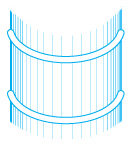
The bands you see on swimming pool cartridges are added to prevent pleat flutter caused by turbulence inside the canister during the filtration cycle. In addition, bands maintain pleat spacing and make cartridge cleaning and maintenance easier.
Skim filters used in spas rarely require bands. This is because the water flow through the element is under less pressure and is more laminar. Furthermore, the generally smaller size of cartridge used in skim filters can actually make separating the pleats for cleaning more difficult if held firmly in place by a band.
Question: What if the band breaks or comes off?
On a well-made cartridge, the bands are carefully adhered to the outer edge of the pleat knuckle and rarely come loose or break in normal use. However, acid soaking or rough handling can cause the bands to break and, in some instances, even separate from the element.
A split band – even if broken in several places – will not affect the filtration performance of the element and is not considered a cause to warranty the cartridge. Loose or missing bands is often a sign that the cartridge is worn out and can be a good indication that it’s time to replace the element.
| Here’s a quick tip. When buying a new filter, place your thumb between the pleats and under the band to check for adhesion. The band should be firmly attached and not separate easily. |
T-380 Red Top
Question: What is the T-380 Red Top?
The T-380 Red Top was the first filter cartridge sold under the Unicel label. The Red Top cartridge, developed in 1984, was the vanguard of the entire Unicel replacement line introduced one year later at the National Expo in New Orleans.
The Unicel T-380 Red Top was also the first filter cartridge to be made using E.I. Dupont’s T-380 grade, 4 oz. Reemay. Developed specifically for the Red Top, T-380 media proved to have such excellent filtration efficiency and cartridge dirt holding capacity that virtually every major filter manufacturer serving the swimming pool industry today has adopted this media.
Both laboratory tests and field usage have proven that Red Top cartridges are easier to clean and last longer than competitive universal-type cartridges. Red Top cartridges easily pass NSF requirements of 70% turbidity reduction in five turnovers, obtaining a 71% reduction in only two turnovers and reaching 98% after five. In addition, the Florida Department of Health and Rehabilitative Services has approved T-380 Red Top cartridges for commercial use.
T-380 Red Top cartridges are manufactured with 6 sq. ft. of media and measure 9 3/4″ in length and 2 3/4″ in diameter. They fit all cluster-type filter housings, including Harmsco, American, Pac Fab, Premier, Rainbow, Swimquip, and Swimrite.
Reemay is the registered trademark of Reemay, Inc. Red Top is the registered trademark of Unicel.
D.E. Grids
Covering Material-polypropylene
Question: What is the covering material used on D.E. filter grids and is this a special fabric?
The cloth used on Unicel’s D.E. grids is 100% Polypropylene. This fiber, a member of the Polyolefin family, has excellent resistance to acids, alkalis, and abrasion, in addition to being both rot and mildew resistant. The use of polypropylene cloth for swimming pool filtration was originally developed by Meissner Mfg. Co. (Unicel’s parent company) during the 1950s. Throughout the forty-year span that polypropylene cloth has been used in this application, this fabric has gone through several modifications. Improvements to critical properties such as yarn construction, weave pattern, and fabric finishing have allowed us to better control the fabric’s “permeability” in order to optimize the D.E. cake handling characteristics. Permeability is the cloth’s flow resistance, expressed in “cubic feet per minute” of airflow as measured with a Frazier permeability machine.
If D.E. grid cloth has too low a permeability, it will blind off quickly, resulting in short filter runs and frequent backwashing. On the other hand, if the material has too high permeability, D.E. can bleed back into the pool. For this reason, all polypropylene grid cloth used by Unicel (and Meissner Mfg.) is woven and finished to our exacting permeability specifications. As a result, we can assure the user the optimum in filtration efficiency, dirt holding, and cake release properties without D.E. kick back or short filter runs.
Recovered Grids
Question: Why doesn’t Unicel re-cover used D.E. grids? It certainly should be cheaper than buying a new set, and everybody wants to recycle, right?
That sounds good, but let’s examine the facts. D.E. grids are made with a specially woven polypropylene cloth cover over a styrene plastic frame. In time, the plastic frame and grid cloth are oxidized by chlorine, weakened by acid and degraded by UV exposure.
Therefore, depending on maintenance, water temperature, and the chemical environment, grids can last anywhere from 6 months to 15 years (and longer).
How long will a re-covered grid last? How old is the frame? 6 months or 15 years? How brittle is the plastic? All you really know is that the fabric has failed. That’s why the grid was re-covered. Since the frame was subjected to the same conditions as the fabric, can its failure be far behind?
But the re-covered grid looks new. The exposed collar is often sanded or polished to appear new. However, plastics are porous and when the skin is broken they absorb moisture, further weakening the frame. In addition, some re-covered grids are made from two or more broken frames which have been cut and glued together. Can you be sure the reassembled grid is the correct length? One grid out of spec will result in D.E. bypass.
A recovered grid may be cheaper, but can you really afford it?
Vertical Grids
Question: Vertical D.E. grids look pretty simple. Is there anything specific to be alert for?
There are two basic designs of “curved” vertical D.E. grids – the slotted collar type used by Pac Fab, American, Hayward, and Sta-Rite, and the notched collar style used in Purex and Swimrite/Premier Atlas filters.
The good news is all four slotted grids, i.e. Pac Fab, American, Hayward, and Sta-Rite, are interchangeable (assuming full size grids are replaced with full size and small grids with smalls). Unicel offers one all-purpose replacement series.
The bad news is the two notched types are not interchangeable. Interchanging Purex and Swimrite/Premier Atlas grids in their respective tanks can cause D.E. to bleed directly into the pool. Purex grids are shorter in length than their Atlas cousins and, if put in an Atlas tank, can pop loose from the manifold during the backwash cycle. Once unseated, D.E. will pass directly into the pool when the valve is returned to the filter mode. Unicel offers two replacement series for notched collar grids.
| If in doubt, measure the grid from the notch to the opposite end. See the Unicel Replacement Guide for exact lengths and correct part numbers. |
